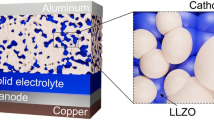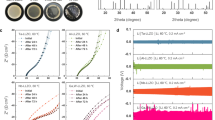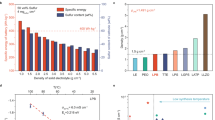Abstract
Batteries are an attractive grid energy storage technology, but a reliable battery system with the functionalities required for a grid such as high power capability, high safety and low cost remains elusive. Here, we report a solid electrolyte-based molten lithium battery constructed with a molten lithium anode, a molten Sn–Pb or Bi–Pb alloy cathode and a garnet-type Li6.4La3Zr1.4Ta0.6O12 (LLZTO) solid electrolyte tube. We show that the assembled Li||LLZTO||Sn–Pb and Li||LLZTO||Bi–Pb cells can stably cycle at an intermediate temperature of 240 °C for about one month at current densities of 50 mA cm−2 and 100 mA cm−2 respectively, with almost no capacity decay and an average Coulombic efficiency of 99.98%. Furthermore, the cells demonstrate high power capability with current densities up to 300 mA cm−2 (90 mW cm−2) for Li||LLZTO||Sn–Pb and 500 mA cm−2 (175 mW cm−2) for Li||LLZTO||Bi–Pb. Our design offers prospects for grid energy storage with intermediate temperature operations, high safety margin and low capital and maintenance costs.
This is a preview of subscription content, access via your institution
Access options
Access Nature and 54 other Nature Portfolio journals
Get Nature+, our best-value online-access subscription
$29.99 / 30 days
cancel any time
Subscribe to this journal
Receive 12 digital issues and online access to articles
$119.00 per year
only $9.92 per issue
Buy this article
- Purchase on Springer Link
- Instant access to full article PDF
Prices may be subject to local taxes which are calculated during checkout





Similar content being viewed by others
References
Chu, S. & Majumdar, A. Opportunities and challenges for a sustainable energy future. Nature 488, 294–303 (2012).
Chu, S., Cui, Y. & Liu, N. The path towards sustainable energy. Nat. Mater. 16, 16–22 (2017).
Armand, M. & Tarascon, J. M. Building better batteries. Nature 451, 652–657 (2008).
Dunn, B., Kamath, H. & Tarascon, J. M. Electrical energy for the grid: a choice of battery. Science 334, 928–935 (2011).
Li, L. Y. et al. A stable vanadium redox-flow battery with high energy density for large-scale energy storage. Adv. Energy Mater. 1, 394–400 (2011).
Wang, W. et al. Recent progress in redox fow battery research and development. Adv. Func. Mater. 23, 970–986 (2013).
Cairns, E. J. et al. Galvanic Cells with Fused-Salt Electrolytes Technical report ANL-7316 (Argonne National Laboratory, 1967).
Shimotake, H., Rogers, G. & Cairns, E. Secondary cells with lithium anodes and immobilized fused-salt electrolytes. Ind. Eng. Chem. Proc. Des. Dev. 8, 51–56 (1969).
Weaver, R. D., Smith, S. W. & Willmann, N. L. The sodium|tin liquid-metal cell. J. Electrochem. Soc. 109, 653–657 (1962).
Kim, H., Boysen, D. A., Ouchi, T. & Sadoway, D. R. Calciume-bismuth electrodes for large-scale energy storage (liquid metal batteries). J. Power Sources 241, 239–248 (2013).
Ouchi, T., Kim, H., Ning, X. H. & Sadoway, D. R. Calcium-antimony alloys as electrodes for liquid metal batteries. J. Electrochem. Soc. 161, A1898–A1904 (2014).
Bradwell, D. J., Kim, H., Sirk, A. H. & Sadoway, D. R. Magnesium-antimony liquid metal battery for stationary energy storage. J. Am. Chem. Soc. 134, 1895–1897 (2012).
Weppner, W. & Huggins, R. Thermodynamic properties of the intermetallic systems lithium-antimony and lithium-bismuth. J. Electrochem. Soc. 125, 71–4 (1978).
Saboungi, M. L., Marr, J. & Blander, M. Thermodynamic properties of a quasi-ionic alloy from electromotive force measurements: the Li-Pb system. J. Chem. Phys. 68, 1375–1384 (1978).
Wen, C. J. & Huggins, R. A. Thermodynamic study of the lithium-tin system. J. Electrochem. Soc. 128, 1181–1187 (1981).
Wang, K. L. et al. Lithium-antimony-lead liquid metal battery for grid-level energy storage. Nature 514, 348–350 (2014).
Ning, X. H. et al. Self-healing Li-Bi liquid metal battery for grid-scale energy storage. J. Power Sources 275, 370–376 (2015).
Li, H. et al. Liquid metal electrodes for energy storage batteries. Adv. Energy Mater. 6, 1600483 (2016).
Lu, X. et al. Liquid-metal electrode to enable ultra-low temperature sodium–beta alumina batteries for renewable energy storage. Nat. Commun. 5, 4578 (2014).
Thangadurai, V., Pinzaru, D., Narayanan, S. & Baral, A. K. Fast solid-state Li ion conducting garnet-type structure metal oxides for energy storage. J. Phys. Chem. Lett. 6, 292–299 (2015).
Liu, K. & Wang, C. A. Garnet-type Li6.4La3Zr1.4Ta0.6O12 thin sheet: fabrication and application. Electrochem. Commun. 48, 147–150 (2014).
Liu, K., Ma, J. T. & Wang, C. A. Excess lithium salt functions more than compensating for lithium loss when synthesizing Li6.5La3Ta0.5Zr1.5O12 in alumina crucible. J. Power Sources 260, 109–144 (2014).
Thangadurai, V., Kaack, H. & Weppner, W. J. F. Novel fast lithium ion conduction in garnet-type Li5La3M2O12 (M = Nb, Ta). Cheminform 34, 437–440 (2003).
O’Callaghan, M. P., Powell, A. S., Titman, J. J., Chen, G. Z. & Cussen, E. J. Switching on fast lithium ion conductivity in garnets: the structure and transport properties of Li3–xNd3Te2–xSbxO12. Chem. Mater. 20, 2360–2369 (2008).
Han, X. et al. Negating interfacial impedance in garnet-based solid-state Li metal batteries. Nat. Mater. 16, 572–579 (2017).
Jalem, R. et al. Concerted migration mechanism in the Li ion dynamics of garnet-type Li7La3Zr2O12. Chem. Mater. 25, 425–430 (2013).
Liu, Y. Y. et al. Transforming from planar to three-dimensional lithium with flowable interphase for solid lithium metal batteries. Sci. Adv. 3, eaao0713 (2017).
Lu, X., Xia, G., Lemmon, J. P. & Yang, Z. Advanced materials for sodium-beta alumina batteries: Status, challenges and perspectives. J. Power Sources 195, 2431–2442 (2010).
Li, G. et al. Advanced intermediate temperature sodium–nickel chloride batteries with ultra-high energy density. Nat. Commun. 7, 10683 (2016).
Chang, H. J. et al. Development of intermediate temperature sodium nickel chloride rechargeable batteries using conventional polymer sealing technologies. J. Power Sources 348, 150–157 (2017).
Ding, M. S. et al. Change of conductivity with salt content, solvent composition, and temperature for electrolytes of LiPF6 in ethylene carbonate-ethyl methyl carbonate. J. Electrochem. Soc. 148, A1196–A1204 (2001).
Tietz, F. et al. Synthesis and Raman micro-spectroscopy investigation of Li7La3Zr2O12. Solid State Ion. 230, 77–82 (2013).
Jin, Y. & McGinn, P. J. Al-doped Li7La3Zr2O12 synthesized by a polymerized complex method. J. Power Sources 196, 8683–8687 (2011).
Gasior, W., Moser, Z. & Zakulski, W. Bi-Li system thermodynamic properties and the phase diagram calculations. Arch. Metall. 39, 355–369 (1994).
Liu, K. & Wang, C. A. Honeycomb-alumina supported garnet membrane: composite electrolyte with low resistance and high strength for lithium metal batteries. J. Power Sources 281, 399–403 (2015).
Acknowledgements
Y.C. acknowledges support from the Joint Center for Energy Storage Research, a battery hub under the US Department of Energy. H.W. acknowledges support from the National Basic Research of China (Grants 2015CB932500), National Natural Science Foundations of China (grants 51661135025 and 51522207). C.A.W. acknowledges support from the National Natural Science Foundations of China (grant 51572145).
Author information
Authors and Affiliations
Contributions
Y.J., K.L., H.W. and Y.C. conceived the idea. Y.J. and K.L. designed the battery cells and conducted the electrochemical measurements. J.L. and Z.H. conducted SEM and XRD characterization. H.W. and Y.C. supervised the project. Y.J., K.L. D.Z., C.A.W., H.W. and Y.C. contributed to writing the manuscript. Y.J. and K.L. contributed equally to this work. All authors discussed the results and commented on the manuscript.
Corresponding authors
Ethics declarations
Competing interests
The authors declare no competing interests.
Additional information
Publisher’s note: Springer Nature remains neutral with regard to jurisdictional claims in published maps and institutional affiliations.
Supplementary information
Supplementary Information
Supplementary Figures 1–19 and Supplementary Tables 1–3
Supplementary Video 1
Vibration and impact experiment of the LLZTO tube
Rights and permissions
About this article
Cite this article
Jin, Y., Liu, K., Lang, J. et al. An intermediate temperature garnet-type solid electrolyte-based molten lithium battery for grid energy storage. Nat Energy 3, 732–738 (2018). https://doi.org/10.1038/s41560-018-0198-9
Received:
Accepted:
Published:
Issue Date:
DOI: https://doi.org/10.1038/s41560-018-0198-9
This article is cited by
-
PVDF-HFP/LLZTO composite electrolytes with UV cure for solid-state lithium rechargeable batteries
Journal of Solid State Electrochemistry (2023)
-
A garnet-electrolyte based molten Li-I2 battery with high performance
Nano Research (2022)
-
Perspective on gallium-based room temperature liquid metal batteries
Frontiers in Energy (2022)
-
Soft and liquid metals
Nature Energy (2021)
-
Electrolytic alloy-type anodes for metal-ion batteries
Rare Metals (2021)



